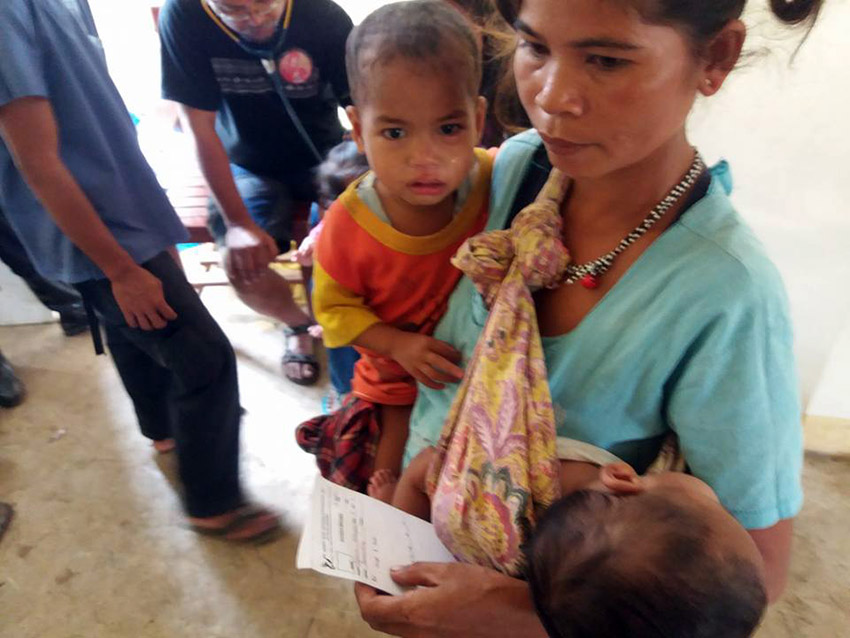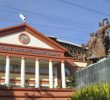
A Lumad mother with her two children during a medical mission held in Talaingod, Davao Del Norte last Friday, Feb. 10. The medical mission was initiated by various cause-oriented groups, volunteers and government agencies. (Photo by Rius Valle)
DAVAO CITY, Philippines—A team of biologists from the University of the Philippines conducted a fecalysis last week in Talaingod, Davao del Norte and found a cholera-like bacteria which was blamed to be the culprit of an outbreak that claimed lives of several Lumad last December.
According to Dr. Ruth Gamboa, Biology professor from UP Mindanao, their finding was not “conclusive” but pointed out the symptoms such as vomiting and diarrhea of the disease that hit the IP community were similar to that of cholera.
“The symptoms were like cholera, but it is still not conclusive for we still need additional laboratory tests,” she said.
The team’s initial findings, Gamboa said, specifically named a water parasite to be the caused of the disease.
“Initially, the parasite from their water is normal.”
Gamboa added that since 2014, a total of 10 Lumad–two adults and eight children— died due to the outbreak when they returned to their community after spending more than a year of refuge in Davao city. In sum, the outbreak already claimed 28 lives since December 2016. Of the 28, 18 were children.
Those who died were several Lumad who stayed at the United Church of Christ of the Philippines – Haran Compound.
“The water here [Davao] is chlorinated, the water in Talaingod is fresh from the spring,” Gamboa said referring to what the Lumad told them about the comparison of the water from two different sources.
“You can imagine that they are desperate of help,” Gamboa said, adding that community members were experiencing symptoms of the said disease and the laboratory results of the fecal and water tests will be released next week.
Medical mission
The medical and solidarity mission was participated in by 83 individuals from different government and non-government organizations. The teams traveled to 14 Sitios in Talaingod.
University of the Philippines Mindanao Biology professors and students joined the solidarity mission from Feb. 9 to 12 in Nasilaban, Barangay Palma Gil at Talaingod.
“We wanted to do some data gathering to get the bigger picture of the outbreak which according to them manifested by vomiting and diarrhea,” Gamboa said.
Aside from medical mission, participants from the Department of Social Welfare and Development also brought relief packs to the community members.
The relief packs contained rice, canned goods, and coffee. Another set of food packs which was intended for children were also distributed.
DSWD Undersecretary Mae Fe Templa said that they gave 2000 food packs for the immediate relief to the 14 communities of Barangay Palma Gil and Dagohoy in Talaingod, Davao del Norte
“We also have mass feeding for about a thousand children,” Templa said.
The mission served 362 patients; 123 males and 213 females. Twenty-six patients from the community also availed of the dental mission.
The medical mission tallied 10 diseases, namely: myalgoa, upper respiratory tract infection, simple cough and colds, gastritis, acute gastroenteritis, urinary tract infection, acid peptic disease, gastroesophageal reflux disease, community acquired pneumonia, and infected wound anemia.
Recommendations
In an 8-page report, the mission recommended that the Lumad need immediate response to their “well-being, illness, and the major contributory factors to poor health such as substandard diet.”
The mission also recommended that basic social services should be provided, particularly in “nutrition, water provision, sanitation, and education.”
“The relief distribution and feeding programs are only band-aid solutions to problems that should be addressed in the long term,” it said, adding that “good water and sanitation services” were also immediately required.
Gamboa said if laboratory results are ready they will coordinate with the Department of Health and the DSWD. (davaotoday.com)










